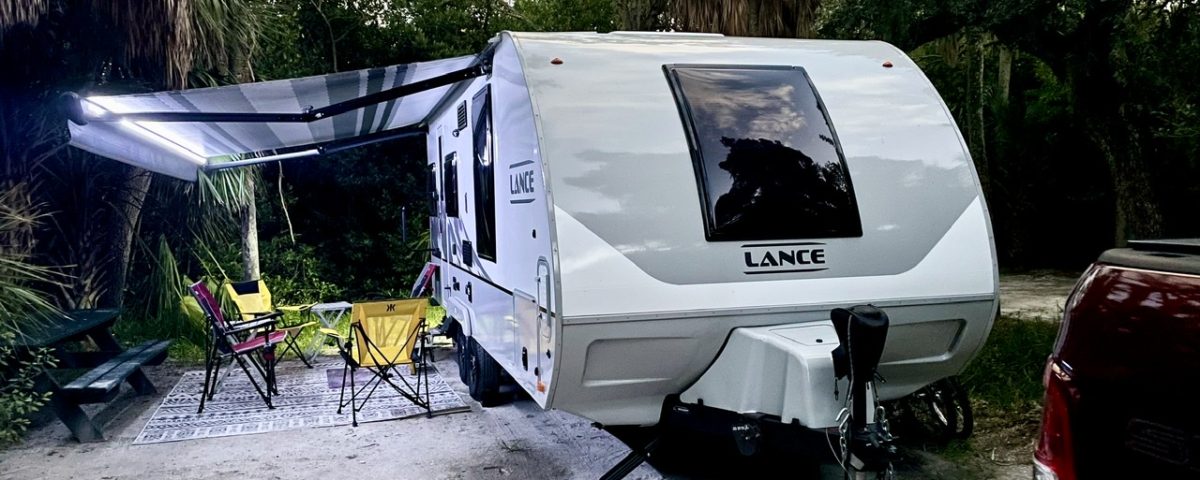T@B 400 Modification
We began our third year of camping with a nüCamp T@B 400 Boondock Lite and we love it! I have provided a link to the NüCamp T@B 400. It is fantastic camper, as was our previous nüCamp product, a T@G MAX XL. The 400 was designed with a lot of input from owners. Consequently, we did not need much in the way of T@B 400 modification. We only made a few changes and most were in the front storage compartment.
Lever on Storage Compartment
My husband saw a Storage compartment lever on a later 400 model that was not on ours. It holds the lid open with a shock. We obtained the part at ùCamp 19 and my husband installed it. It makes it much easier to use the storage compartment.

Enclosed Back of Compartment
The front storage compartment was totally open on the back, which could allow small items to slip through. We don’t carry a lot of small items in there, but wanted the option to do so. My husband added a piece of metal with holes throughout so the area would be ventilated.

400 Modification, 2nd Propane Tank
For future boondocking, we wanted an additional propane tank, especially since our storage compartment is large enough hold it. We had our dealer, Bankston, add the tank and holder while our camper was there for a replacement to a window shade.

400 Modification-Zamp Connector
We purchased a Zamp Solar Suitcase when we had our T@G. However, the T@B 400 does not come with a Zamp connection. Because we hope to do more boondocking using the Zamp, my husband installed the connection. I was very worried about putting a hole in our brand new camper, but he did an amazing job. We have a separate post with step-by-step photos on how he did it: Zamp Connector Added to our New Camper.

New United States Map
We attached our previous United States map to our T@G and we sold it last year. So, we bought a new one just like our old one and filled in the states in which we have camped in both of our campers. Somehow, I find it gratifying filling in that map.

Camper Name
Our new camper has the same name as our first camper. The T@G was named Endeavor, so the 400 became Endeavor II. The T@G’s name was on the back , but that did not work with the 400. We settled on the front of the 400 for the name and I think it looks pretty good.
I ordered the letters from DIY Lettering . It was easy to install and only $25. We also added the blog’s URL in smaller letters on the side of the camper for $24.


400 Modification Not Done
In life, you can’t have everything. We wanted the platform that we see on many T@Gs and T@Bs because it is really nice for storage. I asked the experts at nüCamp about adding it to our 400 while we were in Ohio. Sadly, they did not recommend adding the platform to our model despite the fact that our vehicle can handle a tongue weight of 900 pounds.
We can’t install the platform because our air conditioner is at the front of our camper, which could make the tongue weight too heavy relative to the overall weight of the camper if we added much weight on the platform. The air conditioner for the 2020 model 400 was moved to the back of the camper and it allows the platform to be added. The tongue weight of our 2019 model is 465, while the 2020 model is only 372 pounds.
Warranty Replacement
This was not a modification, but it is something altered on our camper. The shade on our front window became somewhat difficult to close soon after we bought the camper. It bunched up in one side at the bottom. It would only close correctly if done very slowly.
Our dealer, Bankston RV, confirmed that our shade had some issues and a different one was currently being used. Bankston ordered the replacement and installed it. It lowers much easier now. However, because the shade is so large and we want to keep the folds crisp, we keep it down when in our storage facility.
Camping Trips
All of our trips were in our new T@B 400 for this third year of camping. We took five trips and traveled 5,988 miles for a total of 63 nights in the camper. One trip was quite long with 35 nights and we took two trips each at ten and four nights. All our camping was with groups except the trips to new states. This was great because we really like camping with friends.
We have a goal to camp in all fifty states. I am happy to say that we added six new states this year to our map: North Carolina, South Carolina, Virginia, West Virginia, Delaware, and Maryland. Additionally, we camped in Alabama, Georgia, Ohio, and Florida, though not for the first time. Can you tell I was an accountant?
Now Camping Year 4 Begins!































